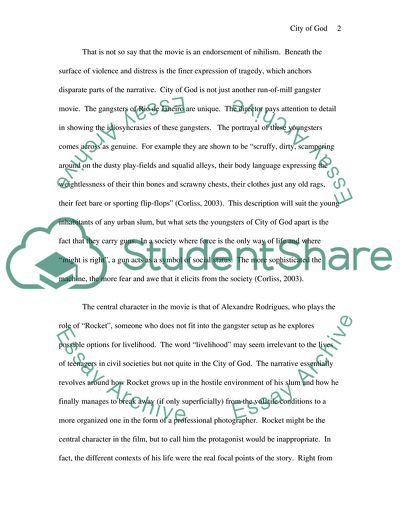Cite this document
(City of God - Film of Despair Term Paper Example | Topics and Well Written Essays - 2500 words, n.d.)
City of God - Film of Despair Term Paper Example | Topics and Well Written Essays - 2500 words. https://studentshare.org/visual-arts-film-studies/1711403-city-of-god-is-a-film-of-dispair-offering-a-one-dimensional-view-of-urban-culture-in-brazil-where-social-divisions-are-too-wide-to-bridge-where-millions-are-t
City of God - Film of Despair Term Paper Example | Topics and Well Written Essays - 2500 words. https://studentshare.org/visual-arts-film-studies/1711403-city-of-god-is-a-film-of-dispair-offering-a-one-dimensional-view-of-urban-culture-in-brazil-where-social-divisions-are-too-wide-to-bridge-where-millions-are-t
(City of God - Film of Despair Term Paper Example | Topics and Well Written Essays - 2500 Words)
City of God - Film of Despair Term Paper Example | Topics and Well Written Essays - 2500 Words. https://studentshare.org/visual-arts-film-studies/1711403-city-of-god-is-a-film-of-dispair-offering-a-one-dimensional-view-of-urban-culture-in-brazil-where-social-divisions-are-too-wide-to-bridge-where-millions-are-t.
City of God - Film of Despair Term Paper Example | Topics and Well Written Essays - 2500 Words. https://studentshare.org/visual-arts-film-studies/1711403-city-of-god-is-a-film-of-dispair-offering-a-one-dimensional-view-of-urban-culture-in-brazil-where-social-divisions-are-too-wide-to-bridge-where-millions-are-t.
“City of God - Film of Despair Term Paper Example | Topics and Well Written Essays - 2500 Words”. https://studentshare.org/visual-arts-film-studies/1711403-city-of-god-is-a-film-of-dispair-offering-a-one-dimensional-view-of-urban-culture-in-brazil-where-social-divisions-are-too-wide-to-bridge-where-millions-are-t.


